Over the last few years, many people have pursued their interest in painting, particularly acrylic painting. But before you start an artistic journey, you need to have the best brushes for acrylic painting, ones having bristles made of polyester or nylon.
Now that you’ve got a quality brush, you must be wondering, “Does acrylic paint expire?” Well, they don’t. Acrylic paint doesn’t technically expire because it’s made of synthetic material.
And due to its formulation, cleaning it off brushes becomes a bit of a challenge, which is not the case with latex paint. So, what is the difference between acrylic and latex paint? Latex paint is water-based, and therefore, gets washed off and fades off much more easily than acrylic paint.
Overall, we prefer acrylic over latex, and if you do too, you should know how to clean paint brushes between colors. So, let’s get straight to the deets!
Ways To Clean Acrylic Paint From Brushes

1. Cleaning Cup
Despite being one of the newest additions, a cleaning cup is our top recommendation to clean paint brushes while painting. Due to their unique design, these cups have been very effective and have gained quite a popularity in the art community.
Using a cleaning cup to remove acrylic paint from bristles entails two steps. First, dab your brush at the textured bottom surface of the cup. And then, rub the brush over the squilgee lips made around the cup rim to eliminate the remaining paint residue. You are now ready to use your brush to dip into another color and continue painting.
However, many people might add a brush cleaner inside the cup to speed up the process, but we’d recommend regular water. With the dual cleaning action in the cup, regular water performs just as well.
2. Cleaning Basin
Next, you could try a cleaning basin to get rid of every bit of paint attached to your brush. Many types of basin options are available and have been used by artists for decades. The basic cleaning principle of a cleaning basin is similar to that of a cleaning cup.
Although varied cleaning cup types feature different designs, most have a common textured base where you can rub your paintbrush. It removes most of the paint from the brush from where you move on to the next section, where you pull the brush bristles to get a clean brush.
Now, if you don’t have a restricted budget or time, a cleaning basin is a quality option. Despite the increased popularity of cleaning cups, cleaning basins are selling just as well.
3. Stainless Steel Brush Washer
Stainless steel brush washer, having the same basic design over centuries, is still popular among painters. It gets the job done, thanks to its stainless steel construction.
It consists of a cleaning plate closer to the base of the washer, where you need to dab if you use large paintbrushes. And in the case of smaller ones, insert the bristles into a hole and apply friction to remove the excess paint attached to it.
Although it’s still a viable choice for many painters, it’s not as effective as a cleaning cup or basin. Its simplistic design with a single cleaning plate might leave behind a few sprinkles of acrylic paint that continue accumulating and hardening over time. And dried paint is more challenging to remove.
So, you can either opt for a more expensive yet high-quality cleaning cup or a less expensive yet effective cleaning basin over this.
4. Multiple Brush Approach
Although it’s not a brush cleaning option, it is preferred by many artists worldwide. Rather than cleaning the same paint brush in the middle of the painting, they prefer to have separate brushes by spending a few extra bucks. You can have a brush for every single color you use in a painting and then store paint brushes properly when switching to another one.
It has two fundamental benefits. If working within a deadline, you can’t afford to wash the same paint brush every time you switch to another color. So, having an extra brush lets you switch from one color to another much faster.
Aside from that, if the paint brush is not properly cleaned before switching to another color, the colors may mix and affect the overall art piece. You wouldn’t want that, right?
Moreover, with higher efficiency and a lower price tag of this method, it’s getting more popular amongst people in the painting community. It is primarily because it allows you to complete the painting in half the time you would have spent cleaning the same brush between paintings.
5. Paper Towel
Paper towel receives a lot of stick from artists around as it’s not an efficient option and also leaves small paper bits inside a brush, which adds to the inconvenience.
Nevertheless, if you don’t want to spend much on cleaning tools, and perform a cleanup, then a paper towel might be a viable option. But, its cleaning job is not as effective as the methods mentioned above.
However, using paper towels is much easier compared to other methods. You need to dip the brush in clean water for some time and apply pressure with a paper towel to remove acrylic paint. Repeat the process until you have a clean brush, and dip it in the end to remove any stuck towel bits. Now, you can get on to painting with the next color.
We do not recommend using this method unless there are no other options. Its disadvantages outweigh its benefits and may force you to switch to another method very soon.
6. Washing With Water
It is probably the least efficient of the methods mentioned above, but it may be the only option for most of our readers and may work fine in some cases.
One of the significant drawbacks of this method is that it requires artists to move away from the paper or canvas to clean the brushes. Walking away from the painting every time you need to wash your brush may disrupt the overall flow of the process.
The basic idea behind this method is to keep rubbing the brush bristles under running water until it’s cleaned thoroughly. It isn’t a very effective process and takes a considerably longer time. And if left with no other option, we’d rather suggest using a different brush for every color.
However, you could use that method along with this one as it will keep your costs low and minimize the time spent.
7. Cleaning With Soap And Water
Regarding cleanup, using mild soap rather than simply rubbing the brush under running water is a much better option. So, here’s how you do it:
Step 1:
Turn on hot and cold water faucets until you get warm water. Rinse the brush for some seconds under the running water, rub it gently, and rotate it for the water to hit each side of the brush. The water pressure pushes away some of the paint, which you can’t do just by wiping the brush.
Step 2:
Put some soap over the brush and gently rub it into the bristles using your fingers. If you don’t have soap available, shampoo is also a viable alternative in this respect.
Once you ensure that the soap has made its way into every corner of the bristles, keep it under the running hot water and rub it gently to get rid of the leftover acrylic paint.
Step 3:
After you finish washing your brush, use a clean cloth or an old newspaper to wipe it and dry thoroughly. Keeping brushes wet for extended periods isn’t advisable.

How To Clean Acrylic Paint Brushes Between Colors Final Words
That brings us to the end of our guide explaining how to clean acrylic brushes in between colors.
We hope following our tips and techniques correctly will help you get a clean brush every time. With the use of most featured methods like cleaning basins and cleaning cups, you can get your brush cleaned in no time. Or you can also use a small amount of solvent like acetone to remove paint from brushes.
It’s also essential to maintain healthy habits while painting. For example, don’t soak your brushes fully in the water while painting for a long time, as it bends and spreads out the bristles.
Also, ensure the paint doesn’t get around the ferrule by not dipping the brushes too deep into the paint. Ferrules are difficult to clean, and it eventually damages the bristles.
With that, it’s a wrap. Happy painting!


